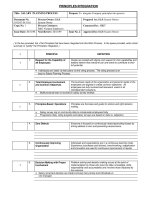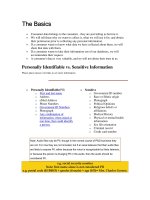Tài liệu Effective communication docx
Bạn đang xem bản rút gọn của tài liệu. Xem và tải ngay bản đầy đủ của tài liệu tại đây (231.38 KB, 42 trang )
EFFECTIVE COMMUNICATION SKILLS
Part 1:
Understanding the communications process – how does
mis-communication occur?
Welcome to the EXPRESS YOURSELF online course!
This 6 part course is designed to make you understand and apply excellent
communication skills in all of your day to day interactions with others.
I recommend that you read, understand and then put into practise what you learn
each week.
You will certainly become a better communicator come the end of the course!
Ready?
Okay, let’s go for it!
Communication is so vital to everything that anyone does because we are usually
required to seek solutions, information and help from others.
It is without doubt the most important skill that anyone can improve and let me tell
you that the results of doing so can be outstanding.
The results can improve your relationships with clients and colleagues, loved ones
and associates – you name it!
Everyone can communicate in one shape or form.
But haven’t you seen those people whose communication and interpersonal skills just
seem to be on another level?
They seem to have everyone doing whatever they say, the person is liked and
respected by all, they can talk to strangers and build up rapport effortlessly!
That’s the difference between communicating and communicating
effectively.
Communication goes far beyond the actual words that you say.
More importantly it’s how you say it and they way that you act while you’re saying it.
It depends on the other persons view of the world and their preferred learning style
with regards to absorbing information and what you say that will determine whether
you are successful in this area or not.
Effective communicators can elicit all of the action signals and communication
strategies from a person and adopt their style to make sure that their
communications are effective.
This course is all about providing you with the communications armoury for you to
be able to communicate effectively with anyone and at any level, it goes far beyond
a beginners guide to communication and focuses upon some more of the advanced
communication techniques available.
You will learn how other people think and how they prefer to learn and thus you will
be able to tailor your communications to maximise your effectiveness.
* EXERCISE *
Write down all of the communications that you have with people.
Take a blank piece of paper and write your name in the middle and then around your
name write down everyone who you have communications with most frequently.
So this will include friends, family, work colleagues, people at your sports club, at the
gym etc. Please write down their names.
As you work through this course keep referring back to this diagram of the people
whom you interact with the most and apply what you learn to them as individuals.
Effective communications are all about tailoring your communications strategy for
each person. NO TWO PEOPLE ARE ALIKE!
The Communications Process
Communication is the transmission of information.
Let’s just think for a moment or two of how the communication process kicks into
action.
Firstly, a person has some thoughts that they want to communicate.
They then put all of these thoughts into a logical sequence.
Then, these thoughts and representations are put into words and then they are then
spoken.
Easy hey!
Ok, so let’s think of the person who is receiving the information.
The words are heard from the second person and then are interpreted to make some
sense.
The sense of the words are now understood by the other persons view of the world
and the filters that they use to understand information and then these
understandings are then expressed as thoughts.
Receive Interpre
t
Understand Thoughts
Thoughts
Represen
t
Words
Speak
So, if communication is so easy how come confusion, misunderstandings and
miscommunication happy all too often?
If we look at the two diagrams once more, we can see that there are two
“THOUGHTS” processes – one at the beginning of the cycle with the communicator
and one at the end of the cycle with the receiver of the communication.
EVERYTHING INBETWEEN THESE TWO PROCESSES ARE INDEED
PROCESSED IN DIFFERENT WAYS BY EVERY PERSON
AND THIS IS WHERE MISCOMMUNICATION COMES FROM!
Let’s have a look to see how this is done.
When someone communicates information to us (through one of the senses), this
information has to pass through an internal filter system, which is basically how we
see the world. (There is a detailed section on this later)
We then REPRESENT this information based upon our filters.
The way that we are feeling at the time, i.e. are we Motivated? Energised?
Depressed? Pleased? Will have a coupling effect with the representation that we
have just made to create an emotional state.
This state, whether good, bad or indifferent will determine our reaction to others and
the event. This ultimately leads to the behaviour that others see when we
communicate back whether it is through verbal or non-verbal methods.
F I L T E R
S
Delete
Distort
Generalise
Internal
Representation
Emotional State
BEHAVIOUR
PHYSI-
OLOGY
INFORMATION
Communicating effectively is all about understanding this process.
Once you know some of the communicating strategies of the other person and you
adopt your style to compliment their strategies you will find that you will
communicate so much more effectively.
Filter Systems
As we mentioned before, information comes in through our sensory input channels.
There are 5 in all but in the context of communication the 3 main channels are:
Visual
This is what we see and the body language and physiology of others
Auditory
These are the sounds we hear, the words spoken and the way that these are spoken
Kinaesthetic
These are split into Internal and external feelings. External feelings include touching
someone or something, what it feels like – texture, pressure etc.
Internal feelings include feelings like hunger, stress, tension, comfort, pleasure etc
The other 2, which are less significant when it comes to communication, are:
Olfactory
The sense of smell
Gustatory
The sense of taste
Information In – Information Out
When information comes in through one of the senses we then process this
information as described in the previous chapter – we modify it as we relate it to our
view and understanding of the world.
This understanding is based upon our filters.
The are 6 main filters:
INFORMATION IN
INFORMATION OUT
Language
We interpret words depending on whether we understand them in the first place and
our previous experience of using them.
For some people, let’s say, the term “Outstanding” could mean the same as another
persons “Good”.
Ask 100 people in a room what “Competitive Advantage” means and you’re likely to
get 30-40 different answers depending on the persons personal experience with that
word and their understanding of what it means.
Language
Meta
Programmes
Belief Systems
V
alues
Decisions
Memories
Meta programmes
Meta programmes are at the hub of your personality and these describe the ways
that you analyse a situation and information.
When you know a persons meta programmes you will then be able to predict their
behaviour and actions a lot better.
There are no right or wrong meta programmes it’s just the way we handle
information.
As these are so important to effective communications I have included a special
chapter to learn these in greater detail.
Values
The third filter is values.
This is your standards or evaluation filter.
Values are our attractions or repulsion’s in life. They are all about what is important
and what is good or bad for us. Because values are about things that are important
to us, they have a great impact on our motivation.
Beliefs
A belief is a feeling of certainty of what something means to us.
All human behaviour is belief driven.
Beliefs are the presuppositions that we have about the way the world is.
Depending upon what they are can either create or destroy our own personal power
to do something.
Beliefs are essentially our on/off switch for our ability to do anything in the world.
There’s an old saying that “Whether you believe you can or your cannot, you’re
absolutely right”
When communicating to someone it is important to elicit their beliefs of WHY they
have done what they have done. On the flip side, when motivating someone, you
might also want to find out the disempowering beliefs that have stopped him or her
from doing what they want to do.
Memories
This filter is all about our recollection of past events.
If someone is saying something to us and we have done it in the past we are going
to make a connection.
And if that same something resulted in a negative experience, we may have built up
a negative belief that it will happen again!
Decisions
The final filter is linked closely to memories and is about the decisions that we have
made in the past.
If we have made some good, bad or indifferent decisions in the past we may have
created some empowering or disempowering beliefs either about the decision itself
or the outcome.
Information Out
Once the information has been filtered through, the information is then either
deleted, distorted or generalised.
We delete certain pieces of information when we only pay attention to certain
aspects of our experiences and not others.
We distort information when we make misrepresentations of reality.
I’m sure we have all seen a ghost’s face on the bedroom wall in the middle of the
night. Or because the bushes in the garden are rustling, there must be burglars
down there!
We generalise information when we draw broad conclusions about what something
means.
For example, if a woman has had a particularly bad relationship with a man she may
say that “All men are the same” and never want to get into a relationship for a long
time.
She has therefore taken one experience and made a generalisation out of it.
* EXERCISE *
APPRECIATING YOUR OWN VALUES AND THOSE OF OTHERS
Part 1:
I’d like you to write down all of your values and beliefs that you have.
For example what things do you like to experience and have? Success? Freedom?
Adventure? Security?
Then I’d like you to write a list of the things you want to avoid? Rejection? Pain?
Failure? Boredom? etc
Then, have a look at your list and do the same thing for the people who you
communicate to the most.
Are you the same? Where do you differ? Build up a mental picture of how they see
the world.
How miscommunication occurs
Miscommunication occurs when we delete, distort and generalise information from
the outside as well as our own thought process.
Our every experience is something that we literally make up inside our heads. We do
not experience reality directly, since we are always deleting, distorting and
generalising.
Let’s just recap once more on how we react and respond to any piece of information.
We receive information via one of our senses.
Our filters then determine our internal representation of that event.
It is our internal representation that puts us in a certain state and this in turns
creates our physiology.
The state in which we find ourselves, will determine our behaviour or reaction to
what happens around us.
Sometimes, the extent of our deletion, distortion and generalisation causes our
version of reality to be sufficiently different to other people’s for misunderstanding,
or even conflict to occur.
That’s it for this module
EFFECTIVE COMMUNICATION SKILLS
PART 2
How to understand someone’s view of the world!
Welcome to Part 2 of the course.
During this module and the next we are going to look into HOW people think the
way that they DO and how YOU should tailor your communication style to meet their
view of the world!
Meta Programmes
As we mentioned in a previous chapter meta programmes are an internal filter that
we pass information through.
They are specifically related to the way that we sort and categorise information.
Knowing someone’s meta programmes allows you to predict their actions but please
note that there are no right or wrong meta programmes.
There are many meta programmes but let’s go through the top 6 that are used in
everyday and business contexts.
• Towards/Away
• Frame of Reference
• Sameness/Difference
• Reason
• Chunk Size
• Convincer
TOWARDS/AWAY
Towards people are always striving to achieve an outcome.
They always want to move towards something.
They want to achieve a certain outcome or goal and find it difficult to recognise what
should be avoided. Instead they concentrate and focus on what they will get when
the outcome is achieved.
Other the other hand, Away from people do things because they want to avoid a
certain situation. They don’t want to experience loss or discomfort and want to move
away from something.
Question? How do you know what type of person they are?
Answer - Ask them this type of question:
What do you want? What will having xyz give you? What do you want in xyz?
What their response will tell you:
Toward people will tell you what they want.
Away from people will tell you what they don’t want.
Using this in the real world:
How to communicate to people who have a TOWARDS and AWAY FROM strategy.
In Negotiations with these people:
Towards
Work out what the goals are and what you can do to help achieve these goals. Focus
on the outcome and what it will give you.
Away
Work out what you can do to help them avoid what they don’t want. Work out and
anticipate potential problems and assure them that these can be minimised or
avoided.
In Managing these people:
Towards
Offer incentives, i.e an outcome. Emphasis goals and what they can achieve and
attain.
Away
Use sanctions. Be aware that these people are usually the ones to bring up
problems.
Influencing Language
Towards
Get, achieve, attain, include, obtain, have, wants
Away
Not have, avoid, don’t want, keep away from, get rid of,
FRAME OF REFERENCE
The second major meta programme is your frame of reference.
This is all about how people evaluate things and can be split out into two:
• Internal People
• External People
Internal People evaluate on the basis of what they think is appropriate. They
make all of the decisions themselves and can have difficulty in accepting other
people’s feedback and direction.
External People evaluate on the basis of what other people think is appropriate.
They need others to help guide, direct and motivate them. They cannot decide for
themselves that they need external references.
Question? How do you know what type of person they are?
Answer - Ask them this type of question:
How do you know that you have done a good job? How do you know that …….?
What their response will tell you:
Internal people will tell you that they decide when they’ve done a good job.
External people tell you that they know because other people or outside
information sources tell them.
Using this in the real world:
In Negotiations with these people:
Internal
Emphasise to the person that they will know inside that you are right. Say that they
have to decide. Don’t bother about external factors or what other people think, they
will not be interested in this.
External
Emphasise what others think. Give them data and information to back things up.
Give them feedback and reassurance.
In Managing these people:
Internal
These people have difficulty in accepted feedback or praise. They like to decide for
themselves and don’t like to be told what to do. They do best when they have little
or no supervision.
External
These people need close management. They need constant feedback and re-
assurance about how well they are doing. They need to be told what to do, how to
do it and how well they are doing it.
Influencing language
Internal
You know best, you’ll know when it’s right, only you can decide, it’s up to you
External
Can I give you some feedback, I will let you know, the facts show, other people think
that,
SAMENESS/DIFFERENCE
This meta programme is all about people’s perceptions of likeness and differences.
There are 4 main categories with this:
Sameness People will notice those things that are the same or match their
previous experiences. They dislike change.
Sameness with exception people will first notice the similarities and will then
notice the differences. They prefer slow or gradual change.
Difference with exception people will notice the differences and then the
similarities. They like change and variety.
Difference people will notice those things that are different. They love change and
want it all of the time.
Question? How do you know what type of person they are?
Answer - Ask them this type of question:
What is the relationship between these three objects? What is the relationship
between this X and a previous Y?
What their response will tell you:
Sameness People will tell you how things are the same.
Sameness with exception people will tell you first how things are similar, then
tell you what differences may be.
Difference with exception people will tell you first how things are different and
then the similarities.
Difference people will tell you what the differences are.
Using this in the real world:
In Negotiations with these people:
Sameness
Stress areas of agreement. Do not discuss differences. Discuss areas of similarities,
how you both want the same thing.
Sameness with exception
First stress similarities and then point out the differences. Talk about change as a
gradual slow process.
Difference with exception
First stress how things are different and only then talk about similarities. Focus on
change and new solutions
Difference
Stress how things are totally different. Do not mention similarities. Talk in terms of
massive change and revolutionary.
In Managing these people:
Sameness
Don’t talk about variety. Talk about continuity. Have them do things the same way.
Sameness with exception
Talk about gradual improvements. Make change a gradual process. Have them do
the same things but with gradual improvements and changes
Difference with exception
Emphasis improvements and changes and downplay commonality. Stress different
ways to do the job and make changes frequently.
Difference
Talk about the differences. Have them do something new all the time. These people
will get bored at repetitive tasks.
Influencing language
Sameness
Same, same as, maintain, keep doing, in common, keep the same, usual
Sameness with exception
Better, more, less, gradual, although, but, same except.
Difference with exception
Different, new, changed, change, unusual,
Difference
Different, new, radical, unique, revolutionary,
REASON
The reason meta programme is all about peoples opinions towards making choices,
developing options and following procedures.
Options People are very good at developing choices. They want to experiment and
are therefore poor at following rules. They are very good at making improvements
and developing new procedures or alternatives to old ones.
Procedures people are good at following procedures, but they do not know how to
generate them. When they have not got a procedure to follow, they become stuck.
Question? How do you know what type of person they are?
Answer - Ask them this type of question:
Why did you choose xyz?
What their response will tell you:
Options people will give you the reasons why they did it.
Procedures people will tell you a story about how they came to do what they did.
They don’t talk about choices or options. They give you the impression that they
don’t have choices.
Using this in the real world:
In Negotiations with these people:
Options People
Concentrate on the choices and possibilities. Discuss all the options. Do not follow a
fixed procedure for the negotiation.
Procedures People
Lay out a procedure for the negotiation. Don’t provide them with options or choices
and don’t expect them to decide on alternatives.
In Managing these people:
Options People
Talk about the possibilities and alternatives. Tell them to think of new ways. Do not
expect them to follow routines. Make sure that they do not violate procedures
Procedures People
Stress the procedures to do the work. Make sure there are procedures in place and
that the person understands them. Be prepared to assist if the procedure fails.
Influencing Language
Options
Alternatives, reasons, options, choices, possibilities
Procedures
Correct way, procedure, known way, right way, proven way,
CHUNK SIZE
People can be categorised into two when it comes down to details.
They are either a detailed person (specific person) or they prefer large chunks of
information (global person).
Specific People give you all the small details. They like to understand and go into
pieces of work with the minutest of detail.
Global People like to talk in big pictures and are not detailed at all. They are
conceptual and abstract. The give you the overall framework or brief of what is
happening rather than going into details.
You know when someone is specific and when someone is global just by asking them
any question!
What their response will tell you:
Specific people will give you all the details and go to great lengths to explain
everything. They give you more and more detail when you ask questions. Specific
people become frustrated with Global People because there is no detail in what they
say.
Global People give you an overview without details. They tend to use large
generalisations. Global People become frustrated with Specific People because they
go into far too much detail
Using this in the real world:
In Negotiations with these people:
Specific
Avoid generalisations and vagueness. Break things down into the detail and be
specific. Present things in logical sequences.
Global
Avoid details and present the bigger picture.
In Managing these people:
Specific
Tell the person in detail what needs to be done and ensure that there is a logical
sequence. Do not expect them to think about the bigger picture
Global
Skip the details and tell the person a broad overview. Tell them what the end game
is and then let them fill in the rest.
Influencing language
Specific
Next, then, precisely, exactly, specifically, first, second, details,
Global
Big picture, framework, in brief, result, generally, overview
CONVINCER
People make decisions and are convinced for only one of four reasons:
It looks right
It feels right
It sounds right
It makes sense
Question? How do you know what type of person they are?
Answer - Ask them this type of question:
Why did you decide xyz?
What their response will tell you:
Looks right people do things because the representation that they make to
themselves is a picture that literally looks right. They will use visual words when
describing their decision
Feel right people do things because the respresentation they make to themselves is a
sensation in some part of their body which literally feels right. They use kinaesthetic
words when describing their decision
Sounds right people do things because the respresentation they make to themselves
is a series of words which literally sounds right to them. They will use auditory words
when describing their decision
Makes sense people do things because the respresentation they make to themselves
is based on logic which in their own mind they know is correct. They will use
auditory words when describing their decision and they will use facts, data and
reason.
Using this in the real world:
In Negotiations with these people:
Us the appropriate language patterns that match their decision process. If providing
learning materials make sure it is appropriate for that person – i.e pictures,
diagrams, facts, data etc
In Managing these people:
Looks right
Paint a picture in words for them. Draw a picture to explain things. Let them imagine
something. Show them how to do it.
Feels right
Have them internally sense what they have to do. Let them get their hands on the
task under supervision and touch, feel and experience what needs to be done
Sounds right
Have them describe to themselves in internal dialogue in an appropriate tone of
voice what they are supposed to do. Tell them things. Tell them what others say.
Makes sense
Give them reasons for what you want them to do. Let them read instructions on how
to do the job. Give them facts, statistics and data.
Influencing language
Appropriate to how they make their decisions. (We are going to look into this in
greater detail in the next chapter)
* EXERCISE *
ELICITING META-PROGRAMMES
Part 1:
Now that you have seen what makes up each of the Meta programmes, what
preferences do you have?
Take time out and have a read through each again and write down below what your
own Meta programmes are for your self-awareness and why?
• Towards/Away
• Frame of Reference
• Sameness/Difference
• Reason
• Chunk Size
• Convincer
Part 2:
In the coming week, listen very hard to your colleagues and friends and elicit their
meta programmes.
Write these down and then formulate of strategy of how best to communicate to that
person.
EFFECTIVE COMMUNICATION SKILLS
PART 3
HOW TO COMMUNICATE WITH DIFFERENT TYPES OF PEOPLE
Welcome to Part 3 of the course!
Last time we looked at getting into the other persons “world” when communicating.
We are continuing that theme this week by looking at how people re-present the
information that you give them in their own minds!
Armed with this you can really hit home your communications in an effective
manner.
Internal Representational Systems
We have already talked about making internal representations in previous chapters
and the meta programme called CONVINCER describes the way that people think
and what they base their decisions on.
We have also described that information comes in one of 5 main senses as well.
Well, it is now time to put all of this together by recognising the thinking process of a
person by listening to the verbal indicators that they use in everyday speech and then
using this information to tailor the way that we communicate to them.
Remember, people like people who are like themselves!
For example if we meet someone who makes decisions because “It looks right” and
uses mainly visual indicators, we will find it easier to communicate to and explain
things to that person if we show him a diagram or by painting him a picture in his
minds eye.
So below is a list of indicators of the words that people use for the 3 main modalities:
Visual Auditory Kinaesthetic Unspecified
See Hear Fell Sense
Look Listen Touch Experience
View Sounds Grasp Understand
Appear Make music Get hold of Think
Show Harmonise Slip through Learn
Dawn Tune in/out Catch on Process
Reveal Be all ears Tap into Decide
Envision Rings a bell Make contact Motivate
Illuminate Silence Throw out Consider
Imagine Be heard Turn around Change
Clear Resonate Hard Perceive
Foggy Deaf Unfeeling Insensitive
Focussed Mellifluous Concrete Distinct
Hazy Dissonance Get a handle Know
Picture Unhearing Solid
Below is a list of indicator phrases that people use, which ones do you use most
often?
Visual Auditory Kinaesthetic
An eyeful Afterthought All washed up
Appears to me Blabbermouth Boils down to
Beyond a shadow of a doubt Call on Chip off the old block
Birds eye view Clear as a bell Come to grips with
Catch a glimpse of Clearly expressed Control yourself
Clear cut Describe in detail Cool/calm/collected
Dim view Earful Firm foundations
Flashed on Enquire into Get a handle on
Get a perspective on Give me your ear Get a load of this
Get a scope on Give you a call Get in touch with
Hazy idea Given amount of Get the drift of
In light of Grant an audience Get your back up
In person Heard voices Hand in hand
In view of Hidden message Hand in there
Looks like Hold your tongue Heated argument
Make a scene Ideal talk Hold it
Mental image Key note speaker Hold on
Mental picture Loud and clear Hot head
Minds eye Manner of speaking Keep your shirt on
Naked eye Pay attention to Lay cards on the table
Paint a picture Power of speech Pain in the neck
See to it State your purpose Pull some strings
Short sighted To tell the truth Sharp as a tack
Showing off Tongue-tied Slipped my mind
Sight for sore eyes Tuned in/tuned out Smooth operator
Staring off into space Unheard of So-so
Take a peak Utterly Start from scratch
Tunnel vision Voiced an opinion Stuff upper lip
Under your nose Well informed Stuffed shirt
Up front Within hearing Too much hassle
Well defined Word for word Topsy turvey
* EXERCISE *
YOUR REPRESENTATIONAL SYSTEM
What words do you use the most?
How do you think?
How would you best learn new material? By a diagram? Listening? Doing
and feeling?
What category do you fit into the most?
Think about your friends and colleagues at work, what modalities do they
use?
Remember, people like people who are like themselves.
If you know that someone is visual – when communicating with him you
should draw him a picture or diagram and use phrases such as “Can you
see it?” and “Just imagine” etc
Eliciting thinking patterns through eye
movement
In the late seventies and early eighties researchers discovered that people move
their eyes in a certain way when they think.
Students were asked a series of questions and the researchers noticed that their eye
movements, when thinking, followed a structured pattern.
They realised that by looking at someone’s eyes, you could tell HOW they think.
You can tell the way they are constructing their thoughts.
The above picture is how the person looks when you are facing them.
There is a basic rule that says when:
People are looking up – They are visualising
People look horizontally to the left and right – They are remembering or
constructing sounds
People look down and to their left – They are accessing their feelings.
V
isual Recall
A
uditory Recall
Kinaesthetic
(Feelings)
V
isual Construct
Auditory
Co
n
st
r
uct
Internal Auditory









